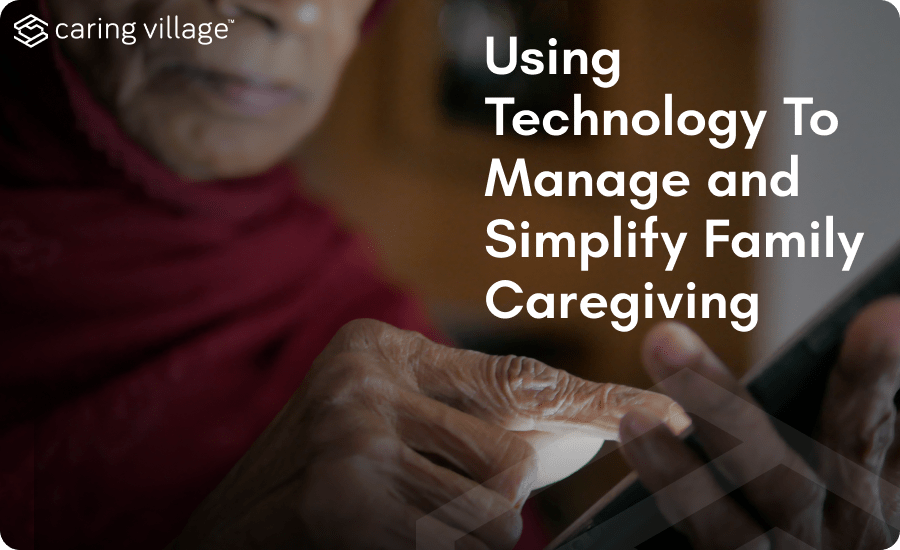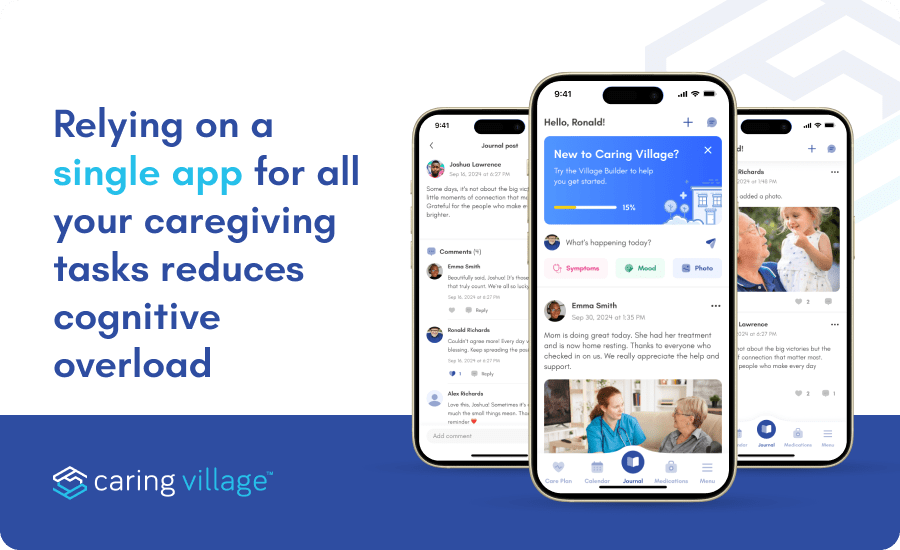
The Caregiver App: Key Takeaways
- Family caregiving in 2025 is increasingly managed through digital coordination, especially for long-distance families.
- Caring Village’s dedicated Caregiver App replaces scattered tools like spreadsheets and chats with one organized system.
- The app’s top features, including AI assistant Julia, medication list, document storage, wellness journal, shared calendar, and messaging, simplify complex care routines.
- Technology supports long-distance caregivers by providing real-time updates, shared tracking, and consistent communication.
- Digital tools can improve caregiver well-being by reducing mental load and fostering emotional connection.
- Ethical caregiving technology prioritizes privacy, transparency, and accessibility for users of all ages and abilities.
- Responsible AI in caregiving complements, rather than replaces, human empathy and decision-making.
Caring for a parent or partner in 2025 often means coordinating across time zones, clinics, and calendars. Modern caregiving blends in-person presence with remote coordination: managing routines, medications, and updates across homes and time zones.
These patchwork systems often lead to missed reminders or confusion about who’s doing what. Caregiver Village’s Caregiver App changes that by keeping all the updates, tasks, and messages in one place.
Caregiving doesn’t have to be chaotic.
What Is the Caring Village App? Why Does Your Family Need It?
The Caring Village Caregiver App is designed to simplify communication and coordination for families caring for older adults or loved ones with health needs. The app creates a private digital “village” where family members, friends, and professionals can share updates, assign tasks, and store essential information securely.
How It Works
Each family member joins a shared care team within the app. From there, you can:
- Post updates
- Upload and safely store documents
- Track medications
- Manage all appointments in a shared dashboard
This creates a single point of truth for everyone involved, reducing confusion and making it easier to respond quickly when needs change.
Why Families Choose It
Families often turn to Caring Village when communication becomes overwhelming. With caregiving spread across siblings or states, it helps ensure no message is lost and no task forgotten.
Features like reminders, document storage, and shared calendars make it ideal for those managing care from multiple locations or juggling work and family responsibilities.
Build a stronger, more connected support system for your loved one.
Why One Caregiving App Beats a Dozen Separate Tools
Many families still rely on workarounds: spreadsheets for medications, chat threads for updates, but these disconnected tools often increase confusion. An integrated platform can offer clarity without adding complexity.
Each system works in isolation, but none provides the full picture. Over time, this fragmentation makes it harder to stay consistent and increases the chance of errors.
The Problem With “Old-Way” Coordination
When care details are scattered across different apps or people’s phones, even small tasks can fall through the cracks. Families often face:
- Duplicate or missed communication: Updates lost in long chat threads
- Disorganized records: Health notes buried in spreadsheets or email attachments
- No accountability: Unclear who’s managing which task or appointment
- Increased stress: Constant follow-ups and confusion drain energy and focus.
These problems compound when caregiving involves multiple family members or long-distance arrangements.
The Value of a Unified Platform
An integrated family Caregiver App like Caring Village replaces the clutter with one organized space for:
- Centralized updates: A single feed for messages, appointments, and reminders
- Shared calendars: Everyone sees the same schedule, reducing overlap
- Task assignments: Clear accountability for who handles what
- Secure storage: Medical documents and contact info kept safe but accessible
This structure mirrors the teamwork families already practice but removes the daily friction of searching for information or repeating messages.
How It Changes the Care Experience
Streamlining communication tools not only reduces administrative fatigue but also frees caregivers to focus on moments of presence and emotional support, the parts of care that matter most. When everyone’s aligned, caregivers spend less time troubleshooting and more time simply caring, a shift that helps prevent burnout before it starts.
Top 5 Features the Caring Village App Provides Family Caregivers

Caring Village's family-focused Caregiver App focuses on practical, easy-to-use tools that simplify daily caregiving. These tools aren’t just practical; they help families stay on the same page, feel less overwhelmed, and spend more time on what really matters.
1. Your Smart AI Caregiver
The built-in AI assistant, Julia, supports users by generating reminders, summarizing care updates, and identifying patterns that could indicate stress or missed tasks. Caregivers can ask Julia for quick checklists or appointment recaps, cutting down on mental load.
2. Medication List
According to the CDC, over 83 % of adults aged 60 and older take at least one prescription drug daily, and many manage multiple medications. Keeping those records accurate is essential for safety. The Caregiver App’s medication list tracks dosages, refill dates, and interactions while allowing multiple family members to confirm updates in real time.
3. Document Storage
Every care team needs easy access to health forms, insurance cards, and emergency contacts. Caring Village’s secure cloud storage organizes these documents in one location with permission controls so family members can view or upload files without worrying about loss or duplication.
4. Wellness Journal
Emotional tracking is just as important as medical tracking. The app’s Wellness Journal lets caregivers log mood, sleep, and behavioral notes: insights that can be shared with healthcare providers or used to identify trends over time. Regular reflection also supports caregiver well-being by encouraging self-awareness and rest when needed.
5. Shared Calendar and Communication Tools
The Caring Village app’s shared calendar and private messaging tools keep families aligned. Every member of the care team can view appointments, coordinate transportation, and confirm visits in one place. Messages, updates, and reminders appear in a unified feed, eliminating long text threads or missed emails.
Instead of juggling five apps and a dozen messages, families finally have a single place to manage care. That kind of clarity can make caregiving feel less like a scramble and more like a system.
Why Tech Matters for Long Distance Family Caregivers
Long-distance caregiving is increasingly common as families live farther apart but stay deeply involved in their loved ones’ care. Data from the Family Caregiver Alliance show that long-distance caregivers are more likely to experience emotional distress (47%) compared to those who live with their care recipient or within an hour’s distance.
Emotional strain often comes from trying to manage health updates, schedules, and daily needs remotely—challenges that digital tools can help ease.
The Challenges of Distance
Distance can complicate even simple tasks. Caregivers may struggle to:
- Track medications or health changes between doctor visits.
- Confirm that appointments, meals, or check-ins actually happened.
- Coordinate siblings or professional aides who live closer to the person receiving care.
- Respond quickly when something unexpected occurs.
When communication depends on calls or text messages, updates can easily become inconsistent or delayed.
How Technology Bridges the Gap
Studies show that simplifying routine coordination with remote monitoring and communication tools can reduce caregiver stress, though specific percentages vary across research. These technologies contribute by:
- Providing real-time health data (like vital signs or sensor alerts) to keep family caregivers informed of sudden changes.
- Automating alerts for abnormalities so caregivers don’t have to constantly monitor every detail themselves.
- Facilitating clear communication between family members, care recipients, and healthcare providers, ensuring everyone is on the same page.
Taken together, these tools support a proactive and shared approach to care, helping reduce uncertainty, last-minute scrambling, and the emotional weight that comes with managing from afar.
Building Confidence Through Reliable Technology
When distance is unavoidable, consistency builds confidence. Reliable caregiver apps make it easier to see what’s happening at home without intrusive surveillance. Many families also rely on useful tools for long-distance caregiving, such as assistive devices and remote monitoring tools that help improve safety and reduce stress for everyone involved.
When caregiving becomes a team effort, it feels less like a burden.
The Caregiver App helps make that shift possible.
How Technology Can Improve Mental Health for Family Caregivers
Caregiving can take a serious toll on mental health: More than half of caregivers report emotional stress, and 41% say caregiving makes them feel lonely, according to AARP. Digital tools can help ease these pressures by simplifying routines, improving communication, and creating small moments of support in everyday caregiving.
Reducing Cognitive Overload

Caregiving involves constant multitasking: managing appointments, medications, and household routines while balancing personal life. Digital platforms reduce mental fatigue by automating reminders, syncing calendars, and displaying real-time updates.
When caregivers spend less time coordinating and more time connecting, stress levels decline and confidence grows.
Strengthening Emotional Connection
Caregivers often feel isolated, especially when loved ones live far away. But even a few shared updates or quick messages can rebuild a sense of closeness over time, and that makes a big difference. Secure messaging and shared wellness notes let relatives check in, offer support, and track progress, building connection and reducing loneliness over time.
Encouraging Self-Care Through Reflection
Many caregivers neglect their own health while focusing on others. Features such as the Wellness Journal in the Caregiver App allow caregivers to record mood and energy levels, helping them recognize early signs of fatigue before they lead to burnout.
Journaling and digital self-tracking have been linked to improved emotional balance and self-awareness.
Ethical Considerations of AI in Caregiving
As caregiver apps adopt artificial intelligence for predictions, reminders, and insights, ethical questions naturally arise. These technologies can improve safety and efficiency, but they also depend on sensitive personal and health data. Understanding where the benefits meet the boundaries helps families use AI responsibly.
Privacy
AI caregiving tools often rely on continuous data collection, from health logs to activity tracking, which raises questions about data protection. Apps that comply with HIPAA and follow transparent data policies help ensure that personal information remains confidential and is never used beyond the scope of care.
Families should review privacy settings and choose platforms that clearly explain how data is stored, shared, and deleted.
Autonomy and Trust
While AI can streamline reminders and pattern detection, families should treat its insights as supportive rather than directive. Human decisions, shaped by context, emotion, and medical input, remain central. Trust in caregiving tech depends on both transparency and humility in how these tools operate.
Building trust requires clear communication about how AI makes recommendations and where human input remains essential.
Tech Overload in 2025
As caregiving tools expand, digital fatigue has become a concern. Studies suggest that receiving frequent notifications and managing multiple digital platforms is associated with higher levels of negative affect and “technostress,” which can undermine emotional well-being.
Simplified systems, those that combine communication, scheduling, and documentation, offer better results than managing several disconnected apps. This is where integrated solutions like the Caring Village Caregiver App stand out by collating information within a single cohesive space.
Accessibility
Technology should be designed for everyone, regardless of age, device, or ability. Many caregivers and older adults still struggle with complex interfaces or limited digital literacy.
Inclusive design, including large text, clear icons, and intuitive layouts, ensures that tech genuinely supports the people who need it most. Platforms built with accessibility in mind expand caregiving equity and independence.
